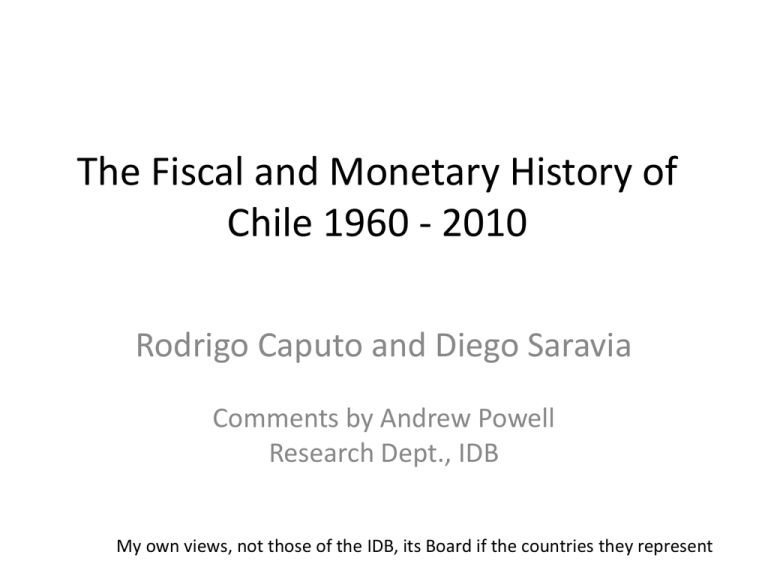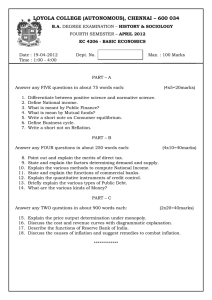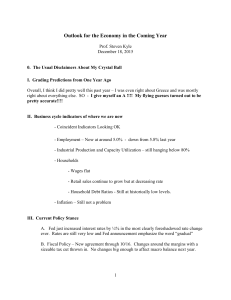The Fiscal and Monetary History of Chile 1960 - 2010
advertisement

The Fiscal and Monetary History of Chile 1960 - 2010 Rodrigo Caputo and Diego Saravia Comments by Andrew Powell Research Dept., IDB My own views, not those of the IDB, its Board if the countries they represent Great Project • As I understand it the idea is to apply a variety of modern economic tools to understand better fiscal and monetary history of LA • LA: has such a rich history, economic tools can help to understand and LA can help us to understand better those tools… • Message to organizers: lets have a future event at the IDB! The Case of Chile • Fascinating history, a true laboratory.. • Incredible plot with a cast of many strong characters and eventually an (almost) Hollywood ending… • The case illustrates the need to combine fiscal and monetary history (not just money) Comments on the Paper • Interesting paper, I learnt a lot… • Some comments on what the authors do • Some comments on what authors do not do… Five “Phases” Identified • 1952-1970. Import substitution strategy, growth almost 4%, budget deficit around 3% and inflation almost 30%, increasing economic inefficiencies, slow motion crises and some reforms… • 1971-1973. Democratic socialism, expansion of government, increasing direct control in key industries, price controls, but monetary financing and inflation soared, hyperinflation • 1974-1983. Stabilization attempts, first more gradual, then deeper, economic reforms, late 1970’s high growth but increased foreign increased foreign debt, non-tradable boom, financial liberalization but weak supervision, early 1980’s devaluation and crisis, bail out of financial sector, need to generate fiscal surpluses • 1984-1992: Growth up to 6.2%, fiscal surplus around 1.5% and inflation averaged 20%, improved financial regulation • 1992 to date: development of inflation targeting regime, fall (finally) in inflation, flexible exchange rate and fiscal rules, stabilization fund for copper and reduction in public debt Economic Tools Applied by the Authors • Import substitution: • Democratic socialism: – Government budget constraint - Sargent – Cagan model: real money balances = f(inflation expectations) • Leading up to the 1982 crisis: – Exchange rate simulation/counterfactual – Krugman first generation bop. crisis • Post 1980’s crisis, adoption of inflation targeting On the Analysis of Government Budget Constraint • Sargent (2013), extended to include foreign currency and indexed bonds • Question: what is the relationship between the returns on each of these instruments? Is anything imposed? • Offhand remark that Government was unable or unwilling to obtain more debt financing, what were the rates paid on these instruments, which was it? • Were there large budget surprises? Was monetary financing related to the surprise? • A distinction is made between indexed and non-indexed debt, but is this important in this period? If so, why? On the Cagan model • Demand for money reflects inflation expectations… • How are expectations formed, in the empirical analysis appears to be this period’s inflation (?) • It is stated both real balances and inflation are I(1) over the period, but no tests are illustrated, how is the period chosen? • Noriega and Ramon-Francia (2013) and Mariscal and Powell (2013) test for changes in the order of integration of inflation… Periods when Inflation is I(0) in Chile Noriega and RamonFrancia (2013) Mariscal and Powell (2013) • Dates of breaks found, considering fractionally integrated series. But neither paper considers a characterization of inflation during the 1970’s Our concern is how to characterize inflation post the last break. Comments on the V-ECM Analysis • If both real balances and inflation expectations are I(1) and co-integrated, does this mean (hyper)inflation is a stable process, could it then have gone on forever? • Or perhaps they are not consistently, during hyperinflation perhaps they are I(x) then I(y) and then (z) where z > y > x But remain co-integrated? That would be quite a different interpretation • In fact the ECM term is hardly significant and the return to equilibrium appears relatively weak • Recommendation: consider endogenous breaks, could apply apply new “saturation” techniques that test for an unknown quantity of breaks of unknown dimension, Hendry, Ericcson and others… The Financial Crisis • I suspect that the financial sector had a bigger role than described, not just fiscal and money • Financial liberalization but with weak supervision, two concerns were: – Allocation of credit, reflecting non tradable boom – Related lending, conglomerates etc. • Strong lessons learned for Chile, and for many other countries in the region • In part due to the lessons learned from the 1980’s and 1990’s, LAC survived Global Crisis… Exit from the Crisis • It is stated that Chile avoided default unlike others in the region, as “default not an option”… • To be applauded of course but I wonder whether that was an optimal strategy. • Most of the literature suggests the costs of default are low, markets are fickle • It stands out as a moral statement in a paper that otherwise applies economic tools.. The Reduction in Inflation and Inflation Targeting • This is a fascinating period but its given very little space in the paper • Inflation was 25% in 1990 when the first inflation target (band) announced for 1991 • Chile also had exchange rate bands and inflation targets simultaneously • Idea was that inflation remained persistently high largely due to expectations, need to provide explicit target. And this seemed to work… Inflation expectations respond to lagged inflation and current Mariscal, Powell and Tavella (2013) inflation shocks but… But effect of inflation shocks on expectations has fallen over time… Not uniformly the case for Brazil Data Sources • For this, we use an IDB database known as Revela, www.iadb.org/revela • But the authors probably have access to individual inflation forecasts • Can look at this disaggregated data and perform additional tests on how Chile’s IT regime gained credibility… Other Comments / Puzzles… • The size of the CB balance sheet and not just Net Worth is of interest, how did Chile “taper” after the crisis • Indexation: how did indexation survive despite its role leading up to the 1980’s crisis… • The dollarization vs indexation debate • And why isn’t Chile “nominalized” today, if inflation truly under control…





